With global energy demands soaring and mounting concerns about pollution and climate change, the shift towards clean energy has become paramount. While nuclear, wind, and solar energy are well-established alternatives to fossil fuels, hydrogen energy is emerging as a potent contender that also does not generate carbon dioxide.
“Hydrogen is an important vector in the energy transition towards carbon neutrality,” Lifeng Liu, a professor at the Songshan Lake Materials Laboratory in China, explained in an email. “It [could not] only be used to decarbonize the transportation sector, […] taking advantage of hydrogen fuel cells, but also finds a wider range of applications in hard-to-abate industries like steel making, synthesis of ammonia/methanol, metal refining, and others, helping in net-zero emissions in these sectors.”
However, no matter how clean this energy is, traditional methods of producing hydrogen through coal gasification and steam reforming are environmentally harmful, which has significantly undermined its potential.
Hydrogen fuel from electrolysis
Fortunately, hydrogen can be produced from pure water, whose molecules are made up of oxygen and hydrogen, in a much more environmentally friendly way through the process of electrolysis.
It involves bringing water into contact with a positively charged electrode, called an anode, where uncharged water molecules are broken down into ions and electrons. These components then travel through different paths to a negatively charged electrode known as a cathode, where, among other by-products, they form pure hydrogen.
“Renewable energy-driven water electrolysis has now been generally accepted to be a promising approach to ‘green’ hydrogen production, and many ‘renewable + water electrolysis’ projects are in the pipeline in many countries,” explained Liu. “However, the shortage of freshwater may become a bottleneck of large-scale deployment of water electrolysers in the near future, especially in Africa where the EU is planning to deploy 40 GW water electrolysers by 2030.”
This shortcoming prompted Liu and his colleagues to look for alternatives. In their study published in Advanced Functional Materials, the team proposed a new method for producing hydrogen from seawater, which accounts for approximately 96.5% of all water reserves on the planet.
Water, water everywhere…
The challenge is seawater contains significant amounts of compounds called potassium hydroxide and sodium chloride. These also participate in the electrolysis process, increasing energy consumption, but do not result in the production of pure hydrogen, while leading to the corrosion of the electrolyzer’s components.
To overcome these hurdles, Liu and the team proposed mixing seawater with hydrazine, a molecule made up of nitrogen and hydrogen, which is known to significantly increase the efficiency of hydrogen generation. They also coated the electrodes with a foil made of platinum and tellurium, which acts as a catalyst in electrolysis, facilitating its progress without participating in a chemical reaction.
The electrolysis device showed promising results: It maintained catalysis at a much lower voltage between the electrodes than conventional seawater catalysis requires, minimizing unwanted side reactions, increasing the reliability of the electrolyzer, and preventing corrosion.
Moreover, the new device generated more energy than it consumed, making hydrogen production self-sustaining.
“The most important findings in our study is that through rational design, seawater electrolysis can take place spontaneously, namely, be self-powered,” explained Liu. “This means if one has seawater and, then she/he can produce hydrogen out of seawater using the devices we proposed without external input of electricity!
“Our devices can help substantially reduce the energy consumption of water electrolysis, thereby showing significant potential for lowering the hydrogen production cost. In addition, our devices allow for operation at low current densities, enabling larger operational flexibility of electrolysers, which is currently also a technical hurdle in real-world operation.”
Promising, but further improvements needed
Despite these impressive results, the researchers admit that their electrolysis method has shortcomings, and scientists still have to overcome many fundamental difficulties to achieve truly clean hydrogen production with it.
“We still need to use platinum [metal] to catalyze the cathodic and anodic reactions,” Liu explained. “In addition to cost, platinum mining is environmentally problematic. “We will aim to develop non-[platinum] based catalysts in the future to lower the cost and reduce the dependence on this scarce [metal].”
“In addition, the use of hydrazine oxidation reactions is the key to reducing energy consumption of electrolysis,” he concluded.
“However, hydrazine is highly toxic and their large-scale usage for water electrolysis may pose some risks to the environment and operators. Therefore, it is necessary to look for an alternative molecule to substitute hydrazine.”
Reference: Zhipeng Yu, et al., Self-Powered Hydrogen Production From Seawater Enabled by Trifunctional Exfoliated PtTe Nanosheet Catalysts, Advanced Functional Materials (2024). DOI: 10.1002/adfm.202403099
Feature image credit: geralt on Pixabay

















